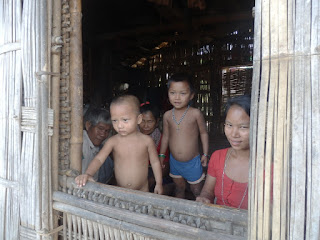The Indian State of Tripura was created in 1947 by the stroke of a
bureaucrat’s pen. In the process, a large number of Tripurans were cut off from
their own people, and left behind in the hills that were a part of the region
around Chittagong.
Oddly enough, it really wasn’t so long ago that the Tripuran King ruled
not only over what is now the Indian territories, but also large swathes of
what is now Bangladesh. Indeed, in Comilla in Bangladesh stands the bungalow
residence of the last Queen of Tripura.
A tall, majestic, and dignified people, the village communities of the
20,000 or so Tripuran people still living in Bangladesh are small, tight knit
groups. For the most part houses still
sit atop stilts, with narrow, notched approach ladders that are said to be
impassable to both snakes and tigers; which seems to say something about the
remoteness, traditionally, of their locations.
The older women are still inclined to be bare breasted around their
homes, and with voluminous threads of beads covering neck and the top of their
chests. Women in the villages weave colourful fabrics that, like those of so
many of the indigenous peoples of Bangladesh as well as other parts of the
world, including Scotland, tell the family and even the family group, or origin
of the wearer.
A fascinating and very friendly people who are welcoming and hospitable.
The journey to Lama, which a number of communities live close to, takes less
than two hours from Cox’s Bazar, provided notice is given to the authorities of
intention to travel a few days in advance. There are other communities closer
to Bandarban, a couple of hours drive from Chittagong, and further into the
hills close to the Indian border.







No comments:
Post a Comment